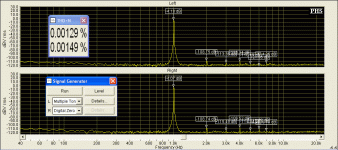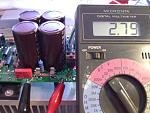Welcome! This thread is for all those who bought my Rev_1.4 PCB based on Mike Bittner's SymAsym – "The Sequel” circuit design. Of course everybody is welcomed, and if you have something to add by all means feel free to jump in.
Attached is a pdf document with step-by-step instructions to help assemble my PCB.
I've also attached the latest BOM, schematics for the amplifier and PS section and some pictures that should help with the assembly process.
To provide some background for those unfamiliar with MikeB's SymAsym - The Sequel design, here's the link to his thread.
http://www.diyaudio.com/forums/solid-state/87609-symasym-sequel.html
Here's the thread that I started describing my original Rev_1.3 PCB design based on MikeB's design.
http://www.diyaudio.com/forums/solid-state/154717-my-new-symasym-pcb-design-rev_1-3-a.html
Note that on the PCB there's a couple labeling mistakes, check page 2 bullets 1&3 of the Assembly Instructions Document for instructions.
I still have a few boards left for those interested.
Regards,
Al
Attached is a pdf document with step-by-step instructions to help assemble my PCB.
I've also attached the latest BOM, schematics for the amplifier and PS section and some pictures that should help with the assembly process.
To provide some background for those unfamiliar with MikeB's SymAsym - The Sequel design, here's the link to his thread.
http://www.diyaudio.com/forums/solid-state/87609-symasym-sequel.html
Here's the thread that I started describing my original Rev_1.3 PCB design based on MikeB's design.
http://www.diyaudio.com/forums/solid-state/154717-my-new-symasym-pcb-design-rev_1-3-a.html
Note that on the PCB there's a couple labeling mistakes, check page 2 bullets 1&3 of the Assembly Instructions Document for instructions.
I still have a few boards left for those interested.
Regards,
Al
Attachments
-
STS100_Rev_1.4_Assembly_Instructions.pdf110.8 KB · Views: 1,462
-
 STS100_Rev_1.4_Amp_Sch.gif27.8 KB · Views: 4,364
STS100_Rev_1.4_Amp_Sch.gif27.8 KB · Views: 4,364 -
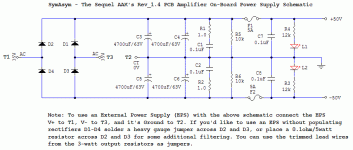 STS100_Rev_1.4_PS_Sch.gif16.1 KB · Views: 4,234
STS100_Rev_1.4_PS_Sch.gif16.1 KB · Views: 4,234 -
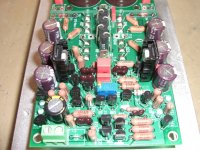 CIMG1390.JPG344 KB · Views: 3,536
CIMG1390.JPG344 KB · Views: 3,536 -
 CIMG1389.JPG281.4 KB · Views: 3,724
CIMG1389.JPG281.4 KB · Views: 3,724 -
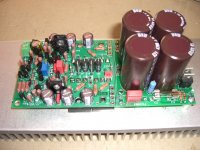 CIMG1388.JPG304.2 KB · Views: 4,018
CIMG1388.JPG304.2 KB · Views: 4,018 -
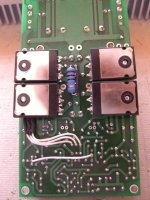 CIMG1393.JPG297.9 KB · Views: 1,849
CIMG1393.JPG297.9 KB · Views: 1,849
I've attached two real world THD plots of the amp driving an 8 ohm load at 100 watts, and a 4 ohm load at 180 watts at 1khz. In each pic the THD plot of the input signal is on top, and the amplifiers output THD on the bottom.
Attachments
I`m waiting for boards an plan to build an amp. I have two transformers. They are both 2x 33Vac/ 600VA. From what I understand using one of them might be enough for a two channel amp?
What C/W - value do I need for the heatsink, each channel, if the psu gives me about 45-46 Vdc?
What C/W - value do I need for the heatsink, each channel, if the psu gives me about 45-46 Vdc?
Voltage rating C24
Hi everybody,
I omitted including the C24 caps my last order at mousers.
How critical is the voltage rating of C24 as I would have some 470/16 in a drawer ?
TIA,
Max
Hi everybody,
I omitted including the C24 caps my last order at mousers.
How critical is the voltage rating of C24 as I would have some 470/16 in a drawer ?
TIA,
Max
Hi,
in normal operation C24 has virtually no AC voltage across and virtually no DC voltage across it.
In failure mode the cap can see either rail voltage across it.
To prevent damage to the capacitor in failure mode one can add a diode across it's terminals to protect it from reverse bias voltage.
It can also be protected against excessive forward bias voltage by adding a second diode in reverse direction.
Some use two diodes in series in both directions so that at +-1Vpk the diodes do not pass, but they limit the worst case cap voltage to <2Vpk.
These diodes can usually be placed on the bottom side of the PCB and easier if you don't clip off the cap leads until after the diodes are soldered in place.
If the cap is diode protected you can use any voltage from 5V and upwards.
Your 470uF 16V is perfect, just add the inverse parallel diodes.
in normal operation C24 has virtually no AC voltage across and virtually no DC voltage across it.
In failure mode the cap can see either rail voltage across it.
To prevent damage to the capacitor in failure mode one can add a diode across it's terminals to protect it from reverse bias voltage.
It can also be protected against excessive forward bias voltage by adding a second diode in reverse direction.
Some use two diodes in series in both directions so that at +-1Vpk the diodes do not pass, but they limit the worst case cap voltage to <2Vpk.
These diodes can usually be placed on the bottom side of the PCB and easier if you don't clip off the cap leads until after the diodes are soldered in place.
If the cap is diode protected you can use any voltage from 5V and upwards.
Your 470uF 16V is perfect, just add the inverse parallel diodes.
Hi Andrew,
thanks a lot for your kind answer.
So, If I get you right it doesn't really matter as the 470/25 as mentionned in the BOM would blow anyway in case of rail voltage, right ?
Maybe you could get back to me per PM as I don't want to pollute this very fresh building thread.
Cheers,
Max
thanks a lot for your kind answer.
So, If I get you right it doesn't really matter as the 470/25 as mentionned in the BOM would blow anyway in case of rail voltage, right ?
Maybe you could get back to me per PM as I don't want to pollute this very fresh building thread.
Cheers,
Max
2 nice posts from AndrewT in the GB thread
Rudi also pointed out another variation in
http://www.diyaudio.com/forums/group-buys/156885-symasym-sequel-aaks-pcb-gb-22.html#post2330387
Hi,
is bd139 important to the performance of the amplifier?
I would use any low current, medium gain, medium fT, To126 NPN for the Vbe multiplier.
I would even consider and have used a To92 glued to the output transistor or the heatsink.
R34=499r may be a bit high. You might have to reduce slightly to 390r, or 430r to allow output bias to be set.
I think the 35mV bias voltage is the sum across both emitter resistors, i.e. 17.5mVre.
R36 to it's maximum resistance for initial setting up.
This ensures least or nil output bias current.
The ratio of R35:R34 is ~4:1. I tend to use from 5:1 to 6:1 to ensure sufficient range of adjustability to suit a wide range of different transistor Vbe.
eg if Q17 has Vbe ~0.55V then the maximum bias voltage is ~2.75V
If the output transistors have Vbe ~0.65V then one needs ~2.65V to get a Vre=25mV. That leaves only 100mV spare for tolerances. But this is worst case design, not for a fully specified design. 499r should work, but will nearest E24 value of 510r work?
Rudi also pointed out another variation in
http://www.diyaudio.com/forums/group-buys/156885-symasym-sequel-aaks-pcb-gb-22.html#post2330387
Last edited:
Fit MKP instead of MKS ?
Hi,
I accidently have some spare 0,1F MKP2 WIMAs (as C10) , would there be a benefit of fitting those instead of the MKS (as C1, C2, etc...) where the physically fit ?
As far as I can see it's a close fit, but workable everywhere but between the diodes on the rectifier board.
Any ideas ?
Cheers,
Max
Hi,
I accidently have some spare 0,1F MKP2 WIMAs (as C10) , would there be a benefit of fitting those instead of the MKS (as C1, C2, etc...) where the physically fit ?
As far as I can see it's a close fit, but workable everywhere but between the diodes on the rectifier board.
Any ideas ?
Cheers,
Max
Hi AAK
Components and boards received, so thanks! I Have a couple of quick questions.
What is the purpose of the optional components C25,R44 and R45?
From the looks of your pictures it seems c25 should be replaced with a jumper if omitted, but not R44 and R45. Is that correct?
In your testing procedure manual you mention temporary 100ohms resistors, but what would be the appropriate wattage for the resistors?
Do you have an image that goes with Testing procedure point 4?
The text reads "Now attach the multimeter probes across one of the 100-ohm resistors as illustrated in and set the multimeter to about 20V."
Components and boards received, so thanks! I Have a couple of quick questions.
What is the purpose of the optional components C25,R44 and R45?
From the looks of your pictures it seems c25 should be replaced with a jumper if omitted, but not R44 and R45. Is that correct?
In your testing procedure manual you mention temporary 100ohms resistors, but what would be the appropriate wattage for the resistors?
Do you have an image that goes with Testing procedure point 4?
The text reads "Now attach the multimeter probes across one of the 100-ohm resistors as illustrated in and set the multimeter to about 20V."
Hi lpm76,
Bypass C25 but leave R44 & R45 open for now. I put R44&R45 on the board because I was curious whether a loaded VAS would make any difference in THD and sound quality, and It was also used in MikeB's original design. I have not had time to play around with it yet but when I do I'll let everybody know how it turns out.
For the protection 100 ohm resistors 1/4 watt will do. I've attached a pic illustrating how to probe across each resistor. When I previewed the post the pic is a bit small, you can find a larger pic in post #24 of the following link.
http://www.diyaudio.com/forums/solid-state/158984-symasym-sequel-aaks-pcb-builders-thread-3.html
Best regards,
Al
Bypass C25 but leave R44 & R45 open for now. I put R44&R45 on the board because I was curious whether a loaded VAS would make any difference in THD and sound quality, and It was also used in MikeB's original design. I have not had time to play around with it yet but when I do I'll let everybody know how it turns out.
For the protection 100 ohm resistors 1/4 watt will do. I've attached a pic illustrating how to probe across each resistor. When I previewed the post the pic is a bit small, you can find a larger pic in post #24 of the following link.
http://www.diyaudio.com/forums/solid-state/158984-symasym-sequel-aaks-pcb-builders-thread-3.html
Best regards,
Al
Attachments
Hi Al,
I was trying to match some Toshiba 2SK170's for the amp to use; however, none of the BL grade that I had could satisfy your matching procedure's 7-8V/2ma target. I ended up using the V grade to match the 7-8V/2ma mark. I suppose it is OK to use the V grade but would like to confirm with those have more experience.
Thanks!!
I was trying to match some Toshiba 2SK170's for the amp to use; however, none of the BL grade that I had could satisfy your matching procedure's 7-8V/2ma target. I ended up using the V grade to match the 7-8V/2ma mark. I suppose it is OK to use the V grade but would like to confirm with those have more experience.
Thanks!!
Hi Al,
I wasn't aware of R44 &R45 being optional, should I take them out again before powering up ?
I am definitely not in a hurry, just finished soldering the resistors only, so there's still some work ahead...
Cheers,
Max
I wasn't aware of R44 &R45 being optional, should I take them out again before powering up ?
I am definitely not in a hurry, just finished soldering the resistors only, so there's still some work ahead...
Cheers,
Max
What are you trying to measure?I was trying to match some Toshiba 2SK170's for the amp to use; however, none of the BL grade that I had could satisfy your matching procedure's 7-8V/2ma target. I ended up using the V grade to match the 7-8V/2ma mark. I suppose it is OK to use the V grade
7-8V is not right.
BL should be OK and some should measure close to what is recommended.
V has too high an Idss for use in circuit with these operating currents.
Hi Andrew,
I used the Jfet Matching Circuit in the assembly manual in the first post. In the diagram, it says "approx 7-8V 2ma between the drain and the ground". I have quite a few matched BL range from low 6ma to high 10ma Idss, but none of them would go below 8V in this matching circuit until I used the V grade. Any suggestion what Idss I should shoot for?
Thanks!!
I used the Jfet Matching Circuit in the assembly manual in the first post. In the diagram, it says "approx 7-8V 2ma between the drain and the ground". I have quite a few matched BL range from low 6ma to high 10ma Idss, but none of them would go below 8V in this matching circuit until I used the V grade. Any suggestion what Idss I should shoot for?
Thanks!!
- Home
- Amplifiers
- Solid State
- SymAsym - "The Sequel", AAK's Rev_1.4 PCB Builders Thread

